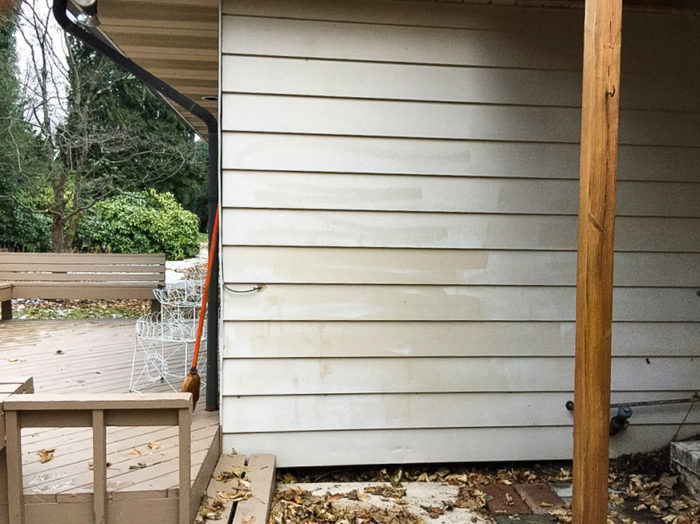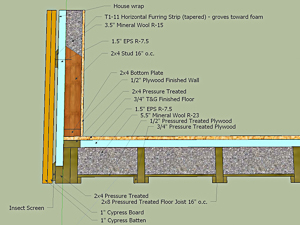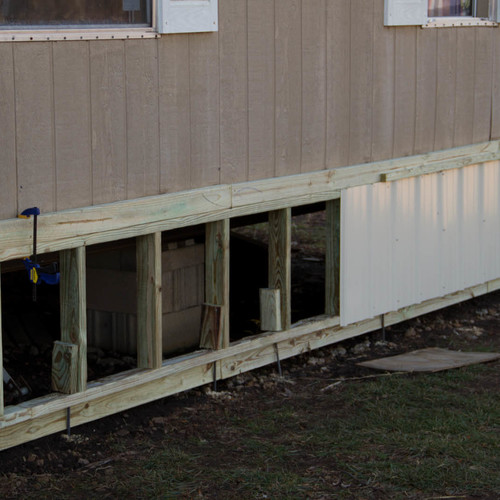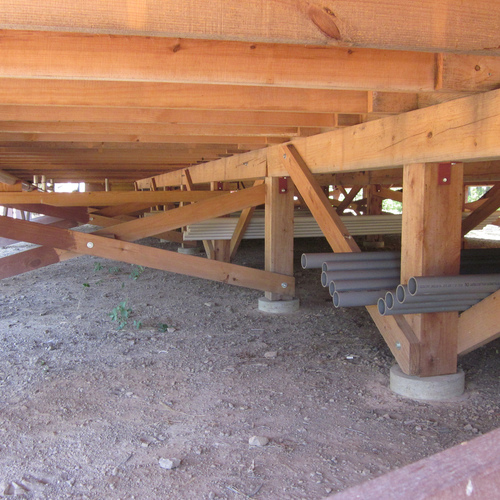
Image Credit: Image #1: Emerson W
The one-room addition on Emerson W’s home is not what anyone would realistically consider over-insulated: R-11 batts in the walls and R-19 at most in the ceiling. But the immediate issue is the floor. There’s no insulation at all there, and because the addition sits on concrete piers, there’s nothing to stop the wind from blowing freely below.
“As you can see, outdoor air can simply pass through the open space under the floor,” Emerson writes in a post in the Q&A Forum. “When the flat EPDM roof needs to be replaced in 5 to 10 years, we will install exterior foam board outside the roof deck. Heating is primarily warmed air from rest of house or from the propane fireplace. Cooling is AC from rest of house.”
Emerson is weighing a plan to excavate below the room to a depth of 2 feet before installing batt insulation between the joists, adding 1 or 2 inches of rigid polyisocyanurate insulation over the joists, and covering the assembly with OSB or plywood.
“What approach would you take?” Emerson asks. That’s today’s Q&A Spotlight.
Digging out is a good idea
GBA Editor Martin Holladay has some suggested reading for Emerson (see the “Related Articles” sidebar below), but in general suggests that digging out the soil from beneath the room is a good first step.
“Excavating the soil under this addition is obviously a good idea,” Holladay writes. “So is adjusting the grade nearby, if possible. If you can afford to put in a real crawl space foundation (with concrete walls), all the better.”
If Emerson keeps the pier foundation, opting not to spend the money on a full crawl space foundation, there are some sound strategies for insulating the floor. But a key consideration in all of this…
Weekly Newsletter
Get building science and energy efficiency advice, plus special offers, in your inbox.

This article is only available to GBA Prime Members
Sign up for a free trial and get instant access to this article as well as GBA’s complete library of premium articles and construction details.
Start Free TrialAlready a member? Log in















16 Comments
Warm elevated floor
Twenty years ago, I built a house on posts - because it was near a flood plain, on a slope, and was a lot more affordable than a full perimeter concrete foundation. Fortunately, I had 3-6' of space available underneath the floor, so there was plenty of room to work. I can't imagine working in a 2' space! Anyway, I installed R-30 fiberglass insulation between the joists, with an air gap between the insulation and subfloor. This floor was very warm! I often walked barefoot on it all winter long without a problem.
Response to Derek Roff
Derek,
Like you, I have never been convinced that Joe's advice on this point is sound. Here's the theory: If the rim joists area (perimeter of the joist bays) is perfectly air sealed, and if there is a perfect air barrier below the fluffy insulation, and if every penetration is perfectly air sealed, then you won't get any air currents in the air space between the top of the fluffy insulation and the underside of the subfloor. Therefore the subfloor will be at room temperature (i.e., warm).
There are two problems with this advice:
1. I have never yet seen a perfectly air-sealed floor assembly. There will be air currents through this air space, and the air currents will degrade the thermal performance of the insulation (and possibly introduce cold outdoor air directly under the subfloor).
2. The air directly above the flooring in many homes isn't really at room temperature anyway. In winter, it's the coldest air in the house. So you might as well beef up the R-value of the floor assembly rather than leaving voids below your subfloor.
3. If everything is perfectly air sealed, and you ignore Joe's advice and fill the bays full of insulation, there will be a thermal gradient across the insulation layer. But the top of the insulation layer is still at room temperature (or whatever the indoor air temperature is near the floor).
Any explanation on the "air space" question?
I read Peter Yost's suggestion for leaving a small air space between the top of the insulation and the bottom of the subfloor. I also read Dr. Joe's linked article (and libelous anti-LEED-rater diatribe), which Peter cites as evidence, in which Dr. Joe asserts that this air space makes the floor warmer. He says that asking "Why?" is a legitimate question. His complete answer, evidence, and documentation is supplied by his sentence, "Old guys taught us this." Meanwhile, Peter shows us thermal images which show that a SIP floor is warmer over a full basement than over outside air at 23 degrees Fahrenheit, or over concrete block. I don't see a relevant parallel to the question posed in this blog, of the temperature of a floor/subfloor with a small airspace between it and the top of the insulation between the floor joists. I'm still hoping to learn why a floor might be warmer with the described air space, and by how much.
Dr. Joe says that filling the cavity completely with insulation is more energy efficient and "reduces heat transfer", but yields a colder floor. I'm puzzled. Heat is coming from the living space, and escaping through the floor/subfloor, through the insulation and joists, and eventually to the outside world. Accepting Dr. Joe's statement that heat transfer is reduced through that floor/subfloor by fully insulating the joist bays, reduced heat flow would suggest more heat retained, hence a higher room temperature and a warmer floor. If reduced heat loss doesn't equal warmer temperatures at the floor, then please explain what is going on.
Dr. Joe also shows some examples of uninsulated steel roof framing and ghosting on the underside of the ceiling. It is easy to understand how uninsulated steel framing would yield a maximum temperature differential with the rest of the ceiling, when the insulation touches the ceiling. I question the relevance of those diagrams to our wood-framed floor joists, with a layer of continuous foam insulation below the joists. While there is sure to be some difference in the floor temperature directly above the joists, it's important to know what that temperature difference is. An insulated wooden joist has an order of magnitude less thermal conductivity than uninsulated steel. Maybe two orders of magnitude. Could the presence or absence of a small air space above the floor insulation change the temperature differential, where the occupant's toes touch the floor, by more than a fraction of a degree, above each joist? Or in the spaces between the joists? What documentation do we have to indicate the magnitude of the temperature differences across the floor surface, with and without a small airspace immediately under the subfloor?
Thanks for your response, Martin.
I appreciate your further discussion. I'm glad to hear that you share my doubts, and I'm still puzzled, even by the idealized theory that assumes no air infiltration/exfiltration/movement. Dr. Joe's position seems to be that fluffy insulation in contact with the subfloor will pull more heat through the floor and subfloor than a thin layer of convection-capable free air above a slightly thinner and cooler layer of fluffy insulation.
If fluffy insulation didn't decrease heat flow, compared to free air, we would throw away all the insulation and use only free air. But we know that the insulation is much better for keeping the warmth inside the house. So I am still having trouble seeing why Dr. Joe claims that throwing away a little bit of fluffy insulation is going to warm up the floor.
> fluffy insulation in
> fluffy insulation in contact with the subfloor will pull more heat through the floor and subfloor
But he writes "Filling the airspace completely reduces heat flow".
As he says, think 2D. Do you agree that flooring immediately above a cold joist will be warmer if the upper part of the joist is heated by the horizontal transfer of heat from the subfloor area not immediately above the joist? An air gap increases this horizontal transfer.
How much does it matter?
It strikes me as a bit of an Angels on a Pin discussion. Compared to other things, like a layer of continuous insulation on the underside, or the conductivity of the finished flooring, does the presence or absence of a small air-space make a difference anyone would notice?
responding to Jon R
I agree that Dr. Joe says that completely filling the airspace reduces overall heat flow through the floor. But he also says that it makes the floor colder. These two statements are hard to reconcile, and it is the point that I am trying to understand. If, in fact, it is true. I agree with Malcolm that it probably doesn't make much difference.
Let's suppose that our floor has joists spaced at 16" on center. To try and figure out what the heat flow might be like, let's look at one linear foot of the top edge of the joist, which comprises 18 square inches. Let's assign to that piece of joist an 8" wide strip of floor and subfloor on each side, that is, halfway to the next joist in each direction. That gives us 192 sq in of floor and subfloor that will thermally interact with each 18 sq in of joist edge. A better than 10:1 ratio.
It's common for both the floor and subfloor to be 3/4" thick, let's say plywood and wood, to make the materials more consistent, adding up to 1 1/2" of thickness on top of the edge of the joist. So let's figure out the R-value of the supposed thermal bridge that the vertical section through our joist is creating. At the bottom, we have an inch of foam, let's call it R-5. Above that, we have 5 1/2" of wooden joist plus 1 1/2" floor and subfloor, for a total of 7" of wood. That wood is probably around R 1.1 or 1.2 per inch, but we can round down to R-1 per inch. So our so-called "thermal bridge" has an R-value of R-12. Gee, the owner told us that the walls are only R-11.
Jon R asks, "Do you agree that flooring above a cold joist will be warmer if the upper part of the joist is heated by the horizontal transfer of heat from subfloor not immediately above the joist?" My answer is, "I don't know, but it seems unlikely to make a significant difference. Our 'cold joist' is really not very cold at all". We want to figure out how much colder or warmer the floor above the joist is going end up, when we fill the last inch of airspace below the floor and subfloor. When the airspace exists, as Jon R says, there will be some horizontal transfer of heat to the top 1" of joist edge, via the air space under the subfloor. Balancing against this, there will be less horizontal transfer of heat from the 192 sq in of wood in the floor and subfloor, because these materials will be a little bit cooler. And at 1 1/2" thick, the slightly cooler floor and subfloor comprise 288 cubic inches of wood adjacent to the top of the joist. The top one inch of joist edge that is picking up heat from the air space contains 18 cubic inches of wood. That amounts to a 16:1 ratio of slightly cooler wood in the floor and subfloor to slightly warmer wood at the top of the joist edge. I don't see the joist edge warmed by the air space as being an overwhelming heat source for the floor surface.
When we fill the whole joist cavity with insulation, we raise the temperature of the floor and subfloor between the joists slightly, and we cool the top edge of the joist slightly. So the temperature differential between the open floor and the strip right above a joist has got to go up some. But we still have a 16:1 ratio in favor of the warmer floor and subfloor. I'm thinking that the difference is going to be fractions of a degree in temperature differential. And it seems that there is a fair chance that every part of the floor will be slightly warmer with the full cavity insulation, compared to leaving an air space.
Probably someone with a thermal modeling program could solve this equation in a few mintues. I'd love to see the figures. In any case, if we fill the joist cavity to R-19 (or R-22, if you believe Owens-Corning's figures for EcoTouch), will that make the floor in this house cold, like Dr. Joe says? Given the Delta T in Emerson W's home in climate zone 4, I'm betting against it.
2 Things
I'll argue Dr. Joe's air gap is a moot point for this reason, people who don't care what the floor feels like under their feet won't notice and people who do care what the floor feels like won't be happy until it's about 80F.
Also, somewhat for the reasons above, I just can't get myself to even consider insulating a wooden floor frame near grade anymore. I've spent a lot of time in 2 block crawls and cost effectively the heat loss to the ground is so minuscule in this situation compared to losses at the perimeter that the effort seams ridiculous to me. The article even seems to point out "the wind blowing freely underneath" as the main problem. I'm not sure what the dimensions and pier layout are here but if I could stretch and seal 6mil poly underneath with a bare minimum of excavation, I would seal and insulate at the perimeter to about 12" below grade. Then, supply a little air to the newly conditioned cavity.
I have no doubt that "warmer
I have no doubt that "warmer floor with gap" applies only to some values of joist conductivity, insulation thickness and air gap thickness. Ie, taken too far, the average floor surface temp would clearly be colder.
I agree that without figures and limits, the entire claim is pretty worthless.
Peter Y says his floor is 5F colder than a floor over a basement. Picking reasonable R values and assuming good air sealing, I find this unlikely - so I'd like to see his numbers.
One solution to floor temp would be to increase room air flow under the top layer(s).
I disagree with Andy that floor temp comfort is so black/white.
Jon
You can find Peter Yost's numbers under the three thermal image scans he provided.
Perhaps my comments were a
Perhaps my comments were a bit over the top and seem black and white. Maybe what I'm trying to say is that floor temp comfort is actually a giant grey area and the gap is not likely to move the needle enough to even notice.
I could be wrong. It would actually be really interesting to set up a building with multiple floor insulation configurations and perform blind foot tests with a sample group.
I'd like to see the numbers
I'd like to see the numbers from Peter (eg, R values and indoor/outdoor temperatures) that lead to a calculated (not measured) floor temperature of 5F below indoor temp. I suspect he has other things going on (like outdoor air infiltration).
Calculated versus actual
I am very interested in this conversation as I am about to build a floor for our new house with SIP panel floors over a pier foundation. We are planning to use 10 1/4" SIP panels in a climate zone 4C. The SIP panels have an R-value of 35. The outside temperature for the peak load heat loss calculation is 22F. My peak heating load will be about 22,000 btu/hr. I used the surface temperature calculation from ASHRAE thanks to Robert Bean’s Healthy Heating website. The equation is Tu=Ta-((U/h)*(Ta-To)) where Tu is the surface temp, Ta is indoor temp, To is outdoor temp, U is U-value, and h is the natural convection coefficient, 1.08 for horizontal surfaces with the heat flow down.
http://www.healthyheating.com/Calculating-inside-surface-temperature.htm#.Wnn1cpPwat9
I calculate that at 22F with an indoor temperature of 72F, my floors will be 70.7F. Ideal temp. for oak floors from the Olesen study is 79F. Btw, I looked at putting in radiant floors and at 22F with a heat flux of 10,000 btuh/sq.ft. my floor temp would be 77F. At 40F they would be 75F vs. 71.1F without radiant. So I opted for not putting in radiant for the 4F difference we would normally see during the winter although I think I would probably pleasantly notice that difference.
If I look at Peter Yost’s situation from his kitchen addition post, I see that he used 6” SIP’s, I’m assuming with R=20. Using the calculation with an indoor air temp of 66F and an outdoor temp of 20F, it says his floor should be 63.9F. I show the outside temp would have to be -20F for his floors to get to 61.8F
I would love to hear any additional thoughts on this. Theoretical often differs from actual and if my floors are going to be significantly colder than the calculation predicts, as Peter’s are, I probably want to rethink what I have planned.
response to Kevin
I worked really hard to get my finished floor surfaces lined up from the existing kitchen to the addition. But I did not anticipate how much of a thermal bridge and convective loop I would have in that 8-inch sectoin over the existing block. That is the really cold section in the middle. If you compare the approximate temperature of the right hand edge of the IR image (over the existing basement) to the left hand edge (over the SIP floor panel), you can see the SIP floor is colder, and in the range your calcs show.
But I could have easily added a "de-coupling space in the SIP floor and that would have helped. But the real mistake is that middle portion, when you come right down to it.
Would I do it with the space if I could do it again? Absolutely. And by the way, my SIP panels--floor, roof and walls were R-38, nominally.
Response to Peter
Very helpful. Thank you. If you don't mind a couple of additional questions, I want to make sure I learn from your experience, which I appreciate you sharing.
I see now looking back at your article that you used polyiso panels. I missed that before. When you say that you might have used a "decoupling space" in the SIP floor are you saying to decouple the SIP floor from the middle portion? Or are you suggesting something similar to what was suggested in the building science article that would have created an air gap between the top of the SIP panel and the bottom of the sub-floor?
Do you believe wind washing across the cold side of the SIP panel has a significant impact? Your panels are probably more protected from that than mine will be. And, do you think an air gap and radiant surface on the cold side of the SIP panel would make a difference? I understand that the heat loss from the panel will be a combination of conduction, convection and radiant but not sure how much of a contribution each will be. Foil faced insulation board between the beams that carry the SIP panels seems like an option if it would be more impactful than say just adding more foam to the panel or going with polyiso panels as you did.
One more question for Peter
It looks like you did a great job sealing the seams of the SIP panels and between the panels and the existing structure. I see that you taped the inside seams with membrane material. Did you also tape the outside joints and if so how did you do that for the underside of the floor panels? Specifically how did you seal the seams in the places where they crossed the carrying beams underneath? Finally, did you foam the joints as the panels were going together, or did you do all of that after they were in place?
Log in or become a member to post a comment.
Sign up Log in